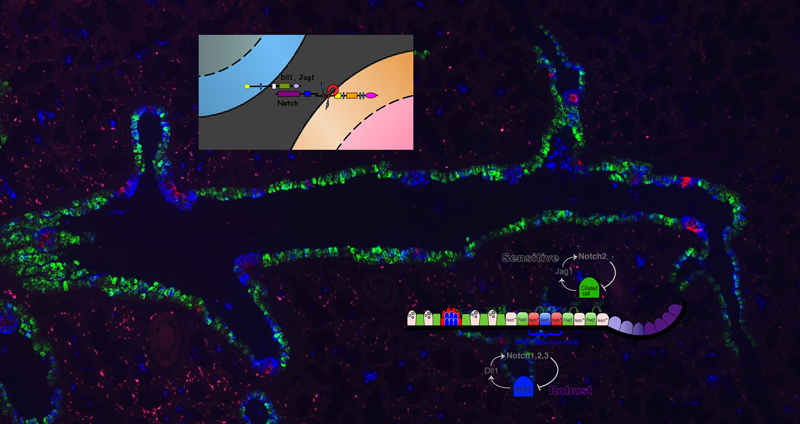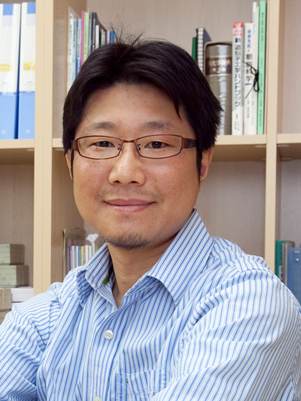Mitsuru Morimoto, Ph.D.
Associate Professor, Division of Developmental Biology (Cooperative Division)
Research Interests

The organs of the body all play critical functional roles,
which are made possible by the arrangement of differentiated cells into the structures
specific to that organ. Such structures are formed throughout
development, with the late embryonic and immediate postnatal periods
being particularly important for the functional maturation of organ
systems. Defects that arise during these organogenetic processes are
closely linked to a wide range of diseases, while after birth the body
is constantly exposed to potentially damaging environmental stresses.
The adult body does manifest a certain degree of regenerative ability,
although this is by no means complete. To study organ formation, repair
and regeneration, we have focused our research on the respiratory system
in mouse.
Respiratory organs in higher mammals are characterized by their
efficient gas exchange, enabled by the functions of specialized cells.
The development of such organs relies on the coordinated activities of
both epithelial and mesenchymal tissue types, which arise from
tissue-specific populations of stem cells in the developing embryo. The
epithelial tissues of the conducting airways serve as the channel for
the intake and exhalation of gases in the respiratory cycle, and are
composed mainly of Clara, ciliated, and neuroendocrine cells. In our
work to date, we have shown how these various cells interact and
exchange information to maintain the appropriate balance in their
respective cell numbers and distributions.
Despite its location in the body’s interior, the respiratory tract is
constantly exposed to environmental factors, such as infection by
viruses and bacteria, smoke, and chemical toxins, that may damage the
airway epithelium. This damage is rapidly repaired by regenerating
epithelial cells supplied by somatic stem cells in the adult tissue, and
as in development, the numbers and distribution of cells in the
epithelium must be maintained at levels appropriate to each region of
the airway.
We focus on issues of how tissue morphology influences the formation of
stem cell niches in the development, repair and regeneration of
respiratory organs, as well as mechanisms regulating cell proliferation
and differentiation in developmental and regenerative processes.
Research Focus
Lung Development and Regeneration
Recent Publication
- Morimoto M., Nishinakamura R., Saga Y. and Kopan R. (2012) Different assemblies of Notch receptors coordinate the distribution of the major bronchial Clara, ciliated and neuroendocrine cells. Development 139, 4365-4373.
- Morimoto M., Liu Z., Cheng H.T., Winters N., Bader D. and Kopan R. (2010) Canonical Notch signaling in the developing lung is required for determination of arterial smooth muscle cells and selection of Clara versus ciliated cell fate. J. Cell Sci. 123, 213-224.
- Demehri S., Morimoto M., Holtzman M.J. and Kopan R. (2009) Skin-derived TSLP triggers progression from epidermal-barrier defects to asthma. PLoS Biol. 7, e1000067.
- Morimoto M. and Kopan R. (2009) rtTA toxicity limits the usefulness of the SP-C-rtTA transgenic mouse. Dev. Biol. 325, 171-178.
- Morimoto M., Sasaki N., Oginuma M., Kiso M., Igarashi K., Aizaki K., Kanno J. and Saga Y. (2007) The negative regulation of Mesp2 by mouse Ripply2 is required to establish the rostro-caudal patterning within a somite. Development 134, 1561-1569.
- Morimoto M., Takahashi Y., Endo M. and Saga Y. (2005) The Mesp2 transcription factor establishes segmental borders by suppressing Notch activity. Nature 435, 354-359.
Contact
Office: Laboratry fro Lung Development, Center for Biosystems Dynamics Research, RIKEN
Tel: +81-78-306-3199
FAX: +81-78-306-3200
E-mail: mitsuru.morimoto@riken.jp
 JAPANESE
JAPANESE 